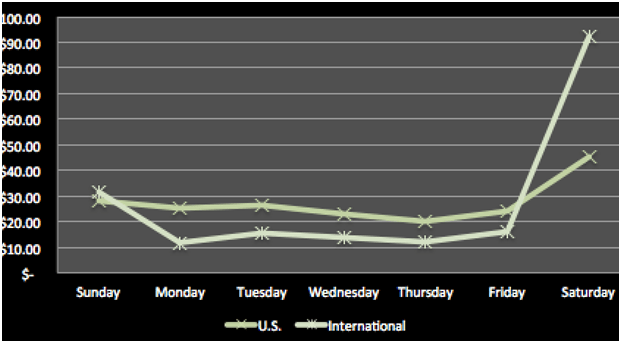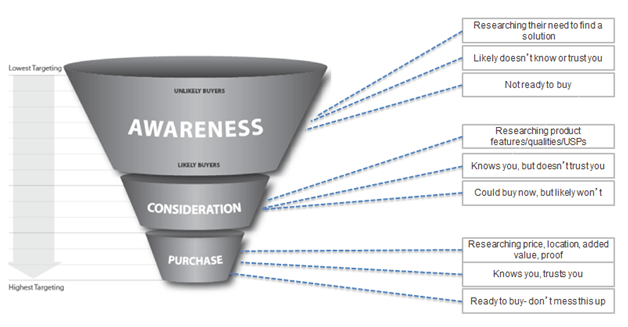The following is an excerpt from a new white paper co-created with Hanapin Marketing. Download the complete white paper here.
In pay-per-click marketing, as with so many things in life, you have to spend money to make money. But how do you figure out what you should spend?
Your monthly and annual budget is a huge part of your PPC strategy, so whether you’re new to PPC or have been doing it for years, it’s worth taking a step back to figure out if you’re making the most of your spend.
The most important consideration for budget planning is your lead needs. You’ll need to sit down and figure out some characteristics of your leads, such as:
- Lead quality
- Target cost per lead (CPL)
- Buying cycle
- Visitor frequency
- Geographic location
If you’re not sure what your target lead looks like, start by answering the following questions:
- What can I afford to spend?
- How do I place value on a “lead?”
- What is my current conversion rate?
- How many leads do I need through PPC?
Let’s take a closer look at the information you’ll need to make smart decisions about your PPC budget.
How Much Budget Do You Need to Get Started in PPC?
Once your marketing team knows the answers to these questions, you can do some basic calculations to help you figure out a budget. Here’s an example of how that math might work:
If you need 250 new clients in a month and your close rate is 15%, then you need a PPC lead goal of 1667 conversions per month to turn 15% of them into 250 leads. If your cost per lead is $25, you’ll need $41,666.67 per month to drive that many leads and clients, or $1388 per day.
What Affects How You Value Your Leads?
The value of a lead will depend on a few factors:
- Geography – Are your leads more or less relevant based on location? Are you willing to pay more for leads from certain areas?
- Frequency of interaction – Do most leads have a complicated attribution system? Are there many “touches” with a prospect before they convert?
- Bounce rate/Time on site – What behavior does your user have post-click? How are they interacting with your site? What is the average dwell time?
- Precedence – What have you seen to be qualified in the past?
You can better control the quality of the leads you bring in through PPC via segmentation strategies like negative keywords (filtering out terms that don’t convert), placements/site exclusions (controlling the sites where your display ads appear), and dayparting (adjusting your bids based on time of day and day of the week). In addition, segmentation helps you better understand if you’re spending your budget wisely.
For example, if you dig into the data of how your PPC ads perform at different times and in different areas, you might find that your CPL on Saturdays, especially for international traffic, is significantly higher than it is on the other days of the week:
At this point, you’d want to ask yourself: Is the quality of those leads I’m bringing in on the weekends worth the extra cost? Or should I dial it back a bit? This is where bid adjustments or just changing your ad scheduling can come into play and help you maximize the allocation of your budget.
Looking for Growth Opportunities
Will doubling your budget give you double the leads? How can you identify your marginal gain from each dollar spent?
It can be difficult to estimate how changes in your budget will affect your overall results, but Google offers some tools to help you in that regard.
I’m sure at some point you’ve seen the “Limited by budget” notification in your Google Ads (AdWords) account. If that’s the case, Google offers a tool that will help you estimate how many more clicks you could expect to get (and at what cost) if you raised your budget:
As you can see, the Google Ads Traffic Estimator (now part of the Keyword Planner tool) shows what Google perceives your growth opportunities to be. Were you to expand your budget by X amount, you could potentially garner Y results. If you haven’t had a lot of experience working outside your current spend levels, these budget estimations, provided through the Google interface, can give you a view of the traffic you’re missing out on.
This table illustrates how you might track your budget settings and adjust your allocations over time. The calculations regarding regular daily spend, remaining spend split over the remaining days of the month, and what changes you need to make – paired with the estimate data – should allow you to establish your budgets for the future.
X vs. Y – Things to Consider When Setting Budgets
Now let’s take a look at how some different scenarios will affect your PPC budget, including:
- Keyword considerations
- Search versus the Display Network
- Search engine (Google versus Bing)
- Device (mobile versus desktop/tablet)
High Funnel Keywords vs. Money Keywords vs. Branded Terms
How should you allocate your budget for different types of keywords? It’s helpful to think in terms of your lead funnel:
At the top of the funnel, people are just exploring their options; they’re not yet ready to buy. This part of the buying process will correspond to top-of-funnel informational keywords; they’re worth something to you, but not as valuable as traffic lower down in the funnel.
In the consideration phase, lower down, you’ll find people who are narrowing down their options and might be ready to buy. These keywords are probably worth more, since they present an opportunity to increase brand awareness and trust.
Finally, you have the very bottom of the funnel, where customers are in the purchase stage. At this point, the customer hopefully already knows and trusts you. These are your “ready to buy, don’t mess this up” keywords – and therefore deserve more of your overall budget.
Here’s an example of a working budget model:
Branded Searches – Good for raising account CTR.
High-Funnel Keywords – Lower Quality Score terms (therefore higher costs) that push to informational offers (lower value).
Low-Funnel Keywords – More competition, but higher QS, and push to trials, demos, sales (higher value for your business).
Those are some basic guidelines, but raise or lower your allocations if …
Search vs. Display
The average share of budget allocated to the Display Network on Google is 19%. However, we allocate a higher percentage – almost half. Why? Because we use remarketing as a form of conversion rate optimization to convert other traffic (recent visitors we want to keep engaged).
It’s a good idea to raise or lower the percentage of budget you spend on Display depending on two factors: your industry and the level of competition.
Some industries actually have a higher average conversion rate on the Display Network than traditional search – if you operate in those industries (like travel and auto), you might want to allocate more budget to display…












0 Comments